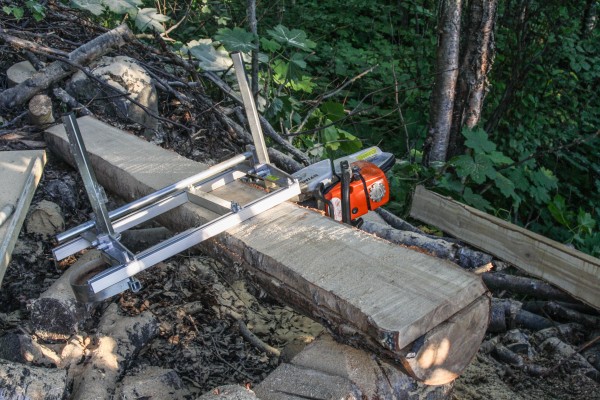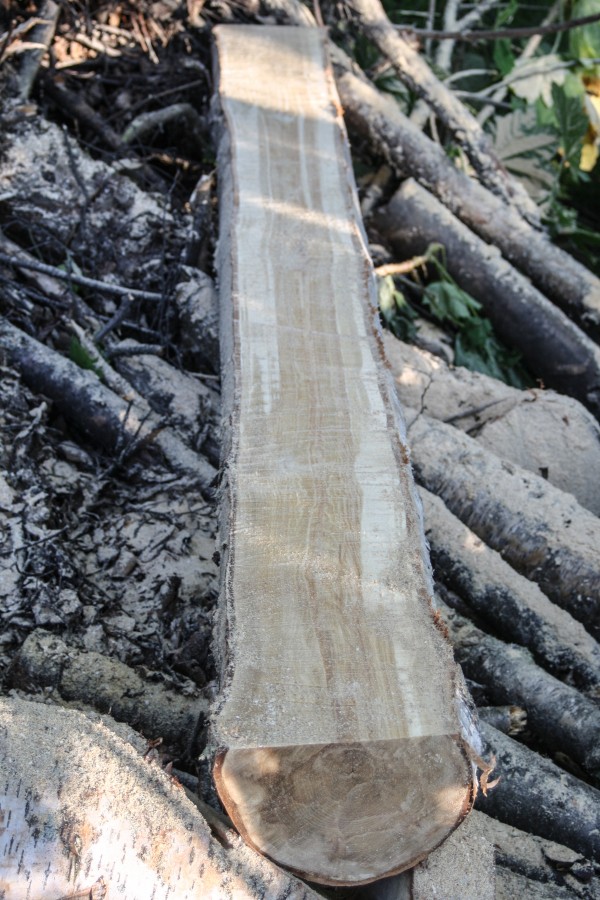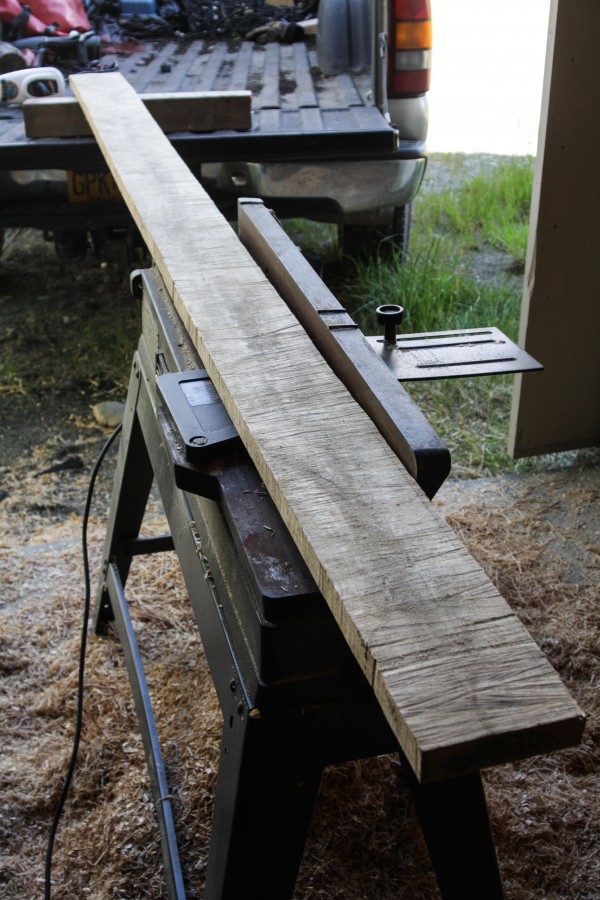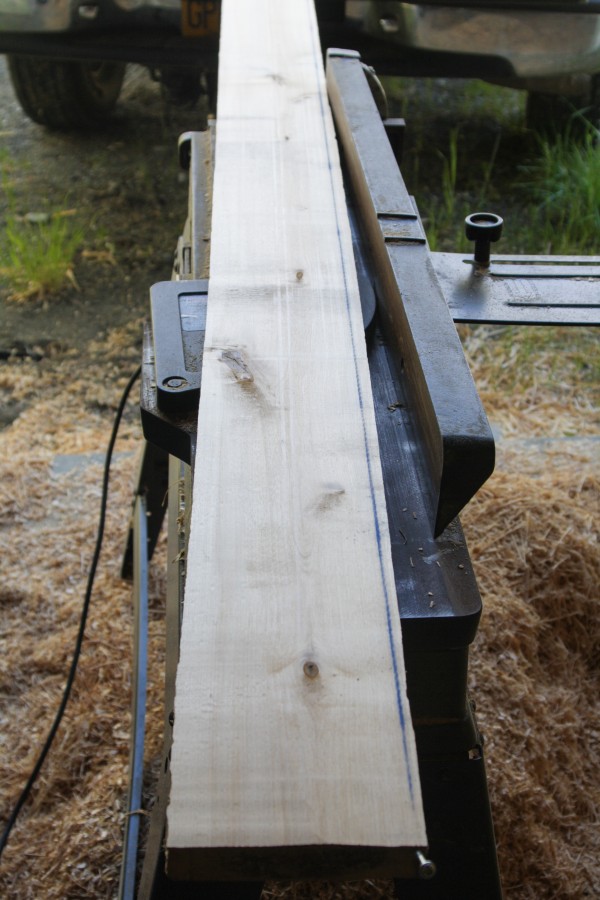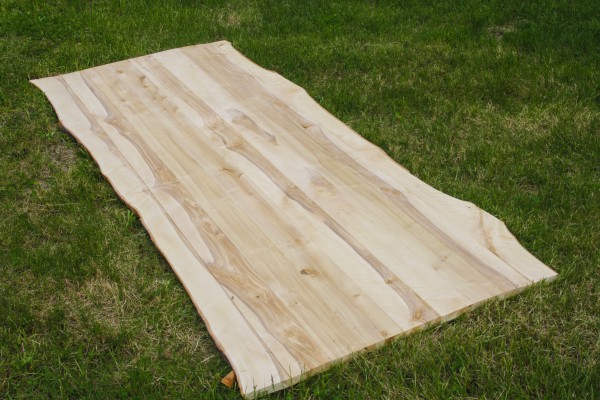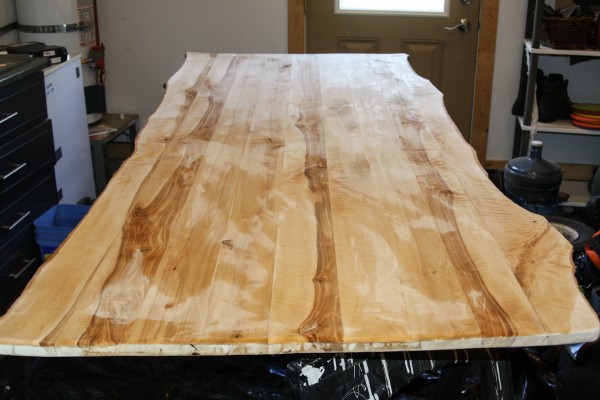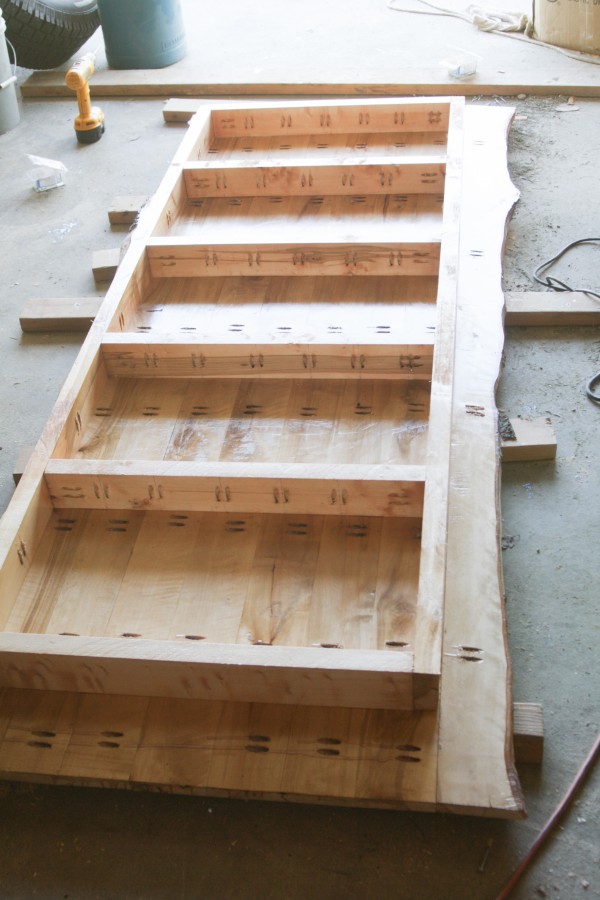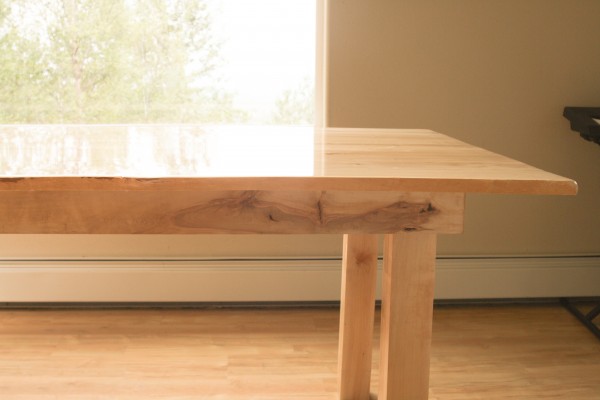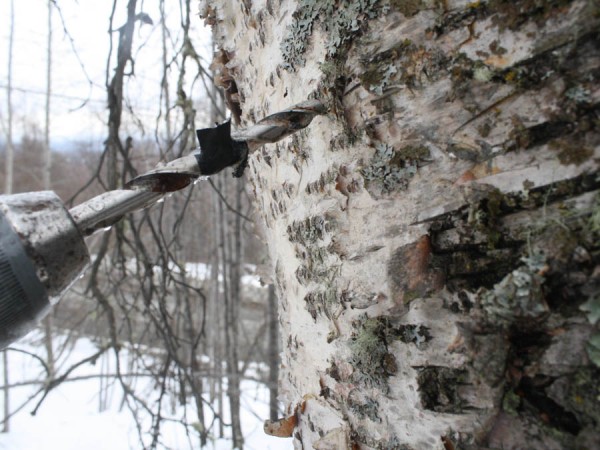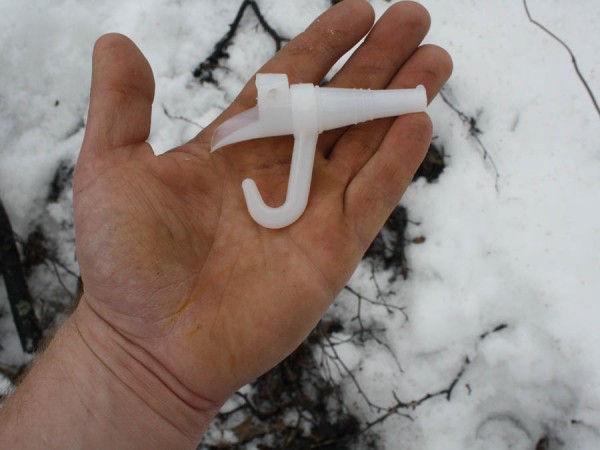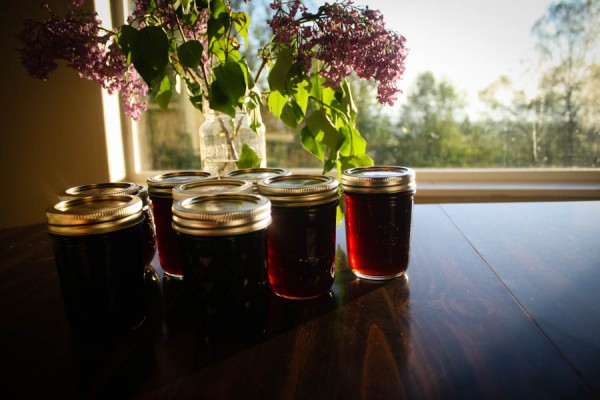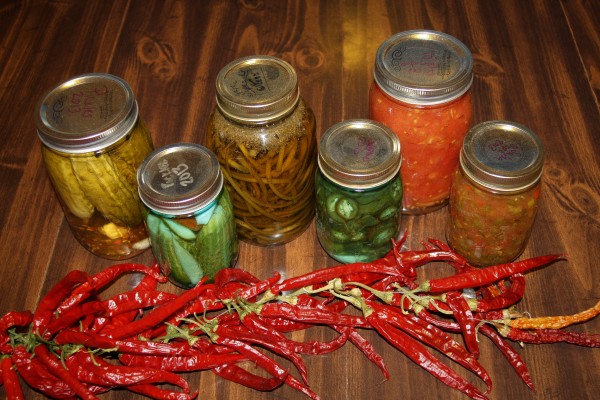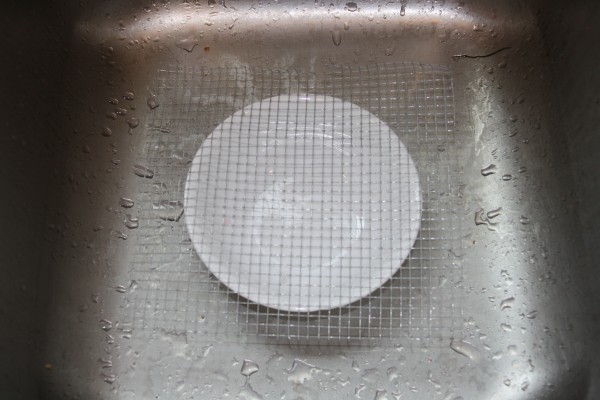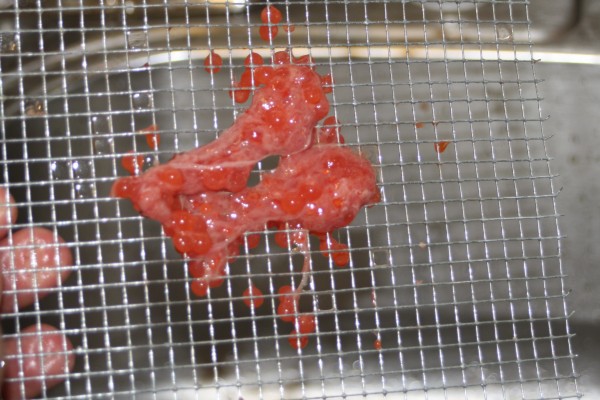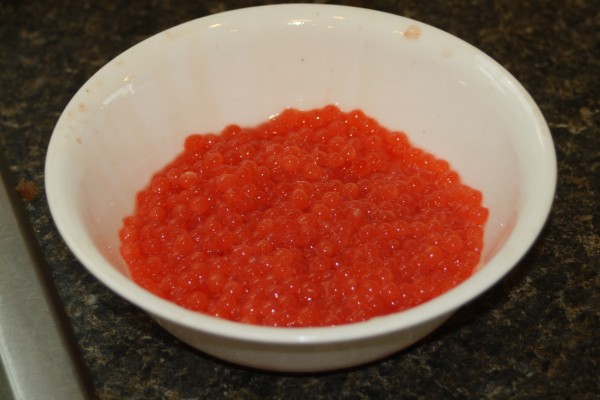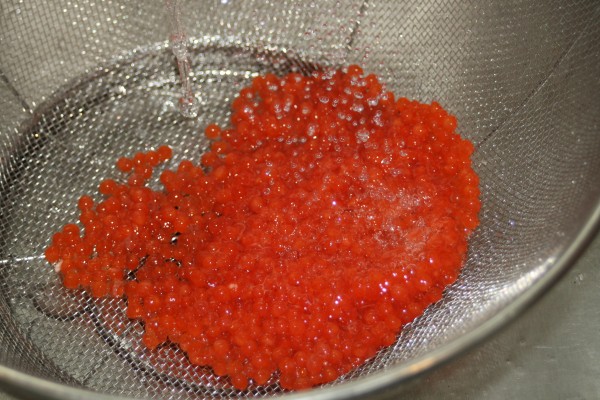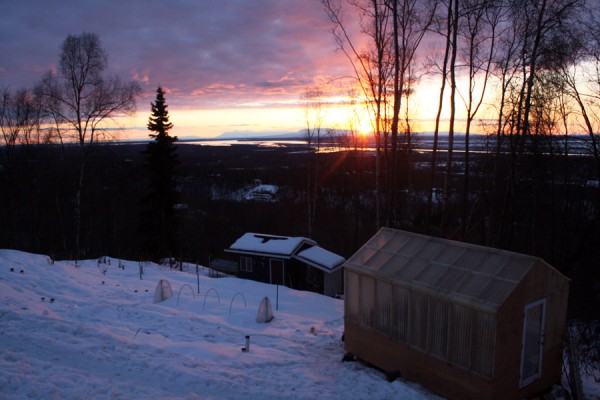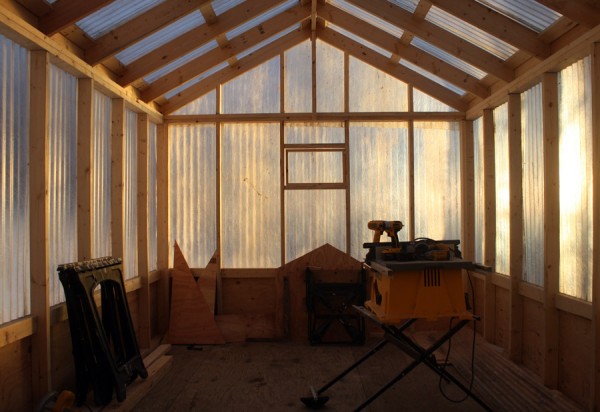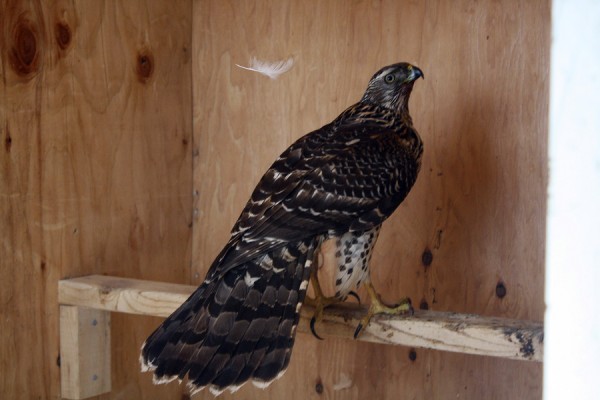40
40. In some ways, it’s just another day, and 40 is simply a number. On the other hand, it’s a milepost that offers a moment for reflection. Life is likely halfway over. Perhaps the “fun half” is already passed (though I hope not). The youthful half is certainly gone. But that’s alright. The last 40 years have been full of adventure, beauty, and growth. My path has crossed with many, many extraordinary people with whom I’ve been fortunate enough to share some days and years and hikes and classes and campfires. The first 40 years haven’t been perfect, and it doesn’t take much reflection to create a long list of ways I could have been a better friend, brother, son, spouse, father, or teacher. And yet, in recent years, I’ve found the words to elucidate my purpose. That purpose is nothing brilliant or profound. It is simply this: When my time comes, I want to leave the world a little better place than I found it. I hope I’ve achieved that. Certainly, there are a few more apple trees growing in Alaska than there once were. Hopefully, there are a few young people who have become better readers, writers, or thinkers. It’s been a good run, and I’m leaving this first half of life with many, many sweet memories.
One of my favorite poems of all time is by William Wordsworth entitled “Lines Composed a Few Lines from Tintern Abbey.” He’s returned to his favorite “nature spot” five years after having discovered it. This time, he’s brought his little sister with him, and he’s reflecting on how he’s changed. Some of my favorite lines are these:
“That time is past,
And all its aching joys are now no more,
And all its dizzy raptures. Not for this
Faint I, nor mourn nor murmur; other gifts
Have followed; for such loss, I would believe,
Abundant recompense.”
Do I hike up mountains as fast as I once did? Certainly not. Do I get enthralled with the “aching joys and dizzying raptures” of youth? Rarely. Will I confront much more grief during the second half of my life? Undoubtedly. And yet, I trust this second half of life will be full of “other gifts.” Wisdom. Contentment. More opportunities to make this world a little better. “Abundant recompense.”
I’m looking forward to the next 40.
October 1st
I am exhausted.
I’ve been hunting every day after work for six weeks, stumbling into the house after dark and hoovering a quick meal before I collapse onto my bed. My wife and her friends call themselves “hunting widows” for the six weeks that comprise moose and caribou season, and I’ve hardly seen her since the end of August.
But I’m not done yet. The greenhouse and much of the garden need to be harvested. For the last month, a pile of wood has sat on the lawn waiting to be split and stacked. Garden implements and my kids’ belongings are scattered throughout the yard. The vehicles need their snow tires put on. I look anxiously at the snow adorning the tops of the nearby peaks and check the forecast for the fourth time today. Can I get all this accomplished before the first snowflakes mark the beginning of our six-month winter?
Summers in Alaska produce a mania among its residents. From the moment the soil is visible in April until the first snows of September or October, many Alaskans tend to fill their days with activities to get them through the winter. Not all of these activities involve storing food or firewood. In our brief Alaskan summers, the land blooms with life, and Alaskans take full advantage of the myriad options for recreation. After all, the winter is long and dark, and biking, backpacking, gardening, and kayaking will be a faint dream by the time January rolls around. Alaskans are as passionate about gathering memories as they are about gathering blueberries. With no darkness in the summer month, we run ourselves ragged chasing caribou or peaks or memories.
William Wordsworth, an English Romantic poet, wrote about this harvesting of memories in his poem “Lines Composed a Few Miles from Tintern Abbey.” Having returned to his favorite “nature spot” after a five-year absence, he reflects upon how these memories made in the mountains will feed him:
While here I stand, not only with the sense
Of present pleasure, but with pleasing thoughts
That in this moment there is life and food
For future years.
I often think about these lines when I’m in the mountains and how the memories made in our brief summer will provide the “life and food” to get us through the dark months of winter, where days of daylight and green vegetation seem like a half-forgotten dream.
This year has been unusual. The summer started with cloudless days and unseasonably warm temperatures. The garden exploded with life, and I think fondly of our gold prospecting trip where us dads hovered over 5-gallon buckets of gravel, expectantly waiting for tiny specks of gold to slowly appear. The kids laughed and played as they floated down the frigid creek in an intertube fashioned from a garbage bag and an abandoned tire. The wives humored us.
This year’s memories will also include huddling under a spruce tree in the driving rain, hoping some moose with more curiosity than sense will walk towards our comically-bad attempts at sounding like a cow moose. The rainy season came early this year; the rain started in mid-July and has been relentless since. My soggy garden, my chilly honeybees, and I are all a little grumpy that our short summer, our season to harvest memories, was marred by record-breaking rain.
It is with these thoughts in mind that I greet October. I’m depressed that a fruitless hunting season is over, but I’m relieved too. I’ll miss traipsing through the woods like a carefree teenager every night and every weekend. I’ve dropped twenty pounds over our manic summer and I’ve seen some beautiful country during the height of our too-brief autumn. But my knee hurts, the to-do list has only grown since hunting season began, and I miss my wife. Six months of manic activity have caught up with me, and the idea of reading a book next to a woodstove as snowflakes gently descend sounds really appealing right now. And at least for now, I pretend like I won’t resent winter in February.
The freezer and pantry are full. Honey, apples, beets, and salmon have been harvested for the year. More importantly, a couple of dozen sweet memories of a summer full of family, friends, and adventure have been neatly packed and stored in my mind. Hopefully, in those memories, there is enough “life and food” to get me through another winter.
Thoughts on Marriage
Note: I recently wrote this for a younger couple I care deeply for.
I thought I’d write out some of my thoughts on marriage. As I stare down 18 years of marriage, I have certainly learned many hard-won lessons. In many ways, I wish I had someone with a lot more experience with marriage and parenthood to tell me what they had learned or discovered. It may have saved me from a whole lot of unnecessary struggle and heartache.
First, I won’t pretend that I know what the fuck I’m doing. I don’t. And all of the “lessons” I’ve learned are ones that I constantly have to re-learn. I might be totally full of shit. Maybe most people have better marriages than I do. At the very least, I wanted to record some of my own thoughts, regardless of their value.
You’re in the hardest part
I wish someone had told me that marriage while raising infants/toddlers was the hardest part of marriage. And I wish someone had told me that it gets better. It really does. Little kids take so much physical and emotional energy; there’s simply not much left to give to our spouse. I think that’s normal and okay, though it doesn’t feel okay in the moment. But I can offer this: It gets easier. Every day is a little easier than the day before. Before you know it –in five or ten years’ time– you’ll have so much more time and energy to contribute to the development of yourself and your marriage. In an ideal world, we wouldn’t have to neglect ourselves or our marriages for the sake of our kids, but I think it’s far more common than you think. If you can make it through the next few years, it gets so much easier. Parenthood and marriage are never easy, and they always take hard work, but it all becomes less overwhelming. You’ll have a little breathing room to care for the neglected parts of your life. In the meantime, soldier on and enjoy every moment of your kids’ first years. It goes by way too fast. Acknowledge that all marriages have really hard seasons. But they’re just seasons that come and go.
Acknowledge that you’re both deeply flawed individuals
This sounds like a simple statement. It’s easy to say, “Fuck yeah, my spouse is deeply flawed! Let me give you the list of his/her personal deficiencies…” It’s a lot harder to look at yourself and acknowledge, on a very deep level, the ways in which you yourself are deeply flawed and constantly fail your spouse. I think it’s helpful to verbalize your flaws to your spouse. Speaking the words gives them more weight. It’s a sign of good faith when you say “I really am a moody/anxious person” or “I’m short-tempered. I’m working on it, even if it doesn’t always seem like it.”
I think the concept of “good faith” is so, so important to a marriage. Even if your spouse is being difficult, if you believe they’re acting in good faith, you at least of a starting point, even if they’re being shitty. Ask yourself, how do you demonstrate that you’re acting in good faith through word and action? Are they the words and actions that your spouse will recognize as a good-faith effort on your part?
When you start from the perspective that you are deeply flawed and have often been a consistently shitty spouse, you start from a place of grace towards the other person. When your spouse is being shitty, break outside of your negative thought cycles and acknowledge that sometimes you are a shitty person as well. And your spouse still chooses to put up with you and extend you grace, even though you’re no picnic to live with.
I think one of the strangely beautiful parts of marriage is the somewhat-cynical acknowledgment that you are both deeply flawed individuals, but that you still choose each other despite those flaws. (We might both be shitty people but at least we’re shitty people together!) For many years I thought that my goal and responsibility was to build a perfect marriage. I had this clear vision of how wonderful our marriage could be! (Of course, in my mind, it conveniently meant there were 27 things my spouse needed to change for that to happen! I was fine, it was her deficiencies that were holding us back. That line of thinking is simply bullshit.)
I think the other critical aspect is to simply accept your spouse, flaws and all. It’s incredibly unlikely that you are going to change them, despite your best efforts or intentions. To this day, there are so many things I wish my spouse would do/be. But that’s a dangerous line of thought, one that leads to a lot of discouragement, discontent, and resentment.
For instance, my spouse is never going to be a particularly reflective individual; she lives in the moment. She’ll never be particularly philosophical or poetic. That’s okay. She has lots and lots of good qualities that I often don’t appreciate simply because they’re not the qualities I want her to have. That’s not fair to her. Despite whatever I perceive as her shortcomings, the fact is that I have committed my life to this deeply flawed person. She has done the same with me. Our marriage took a profound turn for the better when we stopped trying to change one another and simply learned to love and accept each other, flaws and all. She r
Virtuous and destructive relationship spirals
My spouse and I have a very consistent pattern of conflict.
- One of us gets our feelings hurt. Often the other person criticized us, didn’t acknowledge us in the way we wanted, or did something we perceive as inconsiderate or malicious. There other person’s intentions are rarely as malevolent as we think, but one of us is deeply hurt and feels attacked.
- We get defensive. Whether we are the one who originally felt hurt or the one who feels attacked, we immediately put up walls and start justifying our behavior. Any conversations or arguments we have during this stage are usually futile or make things worse. Our hackles are up, we aren’t deeply listening to each other, and we are both lobbing emotional grenades at each other. This is when 20 years of history is brought up, rehashed, or used as evidence for our “clearly-I’m-right-because-look-at-this-evidence” attitude.
- I start to ruminate. I can’t speak for my wife on this one, but I usually spend the next few days in a pretty dark place. My thoughts spiral. (More on spirals later).
Just a couple of weeks ago we got into a pretty good argument. It was about a topic we have had countless arguments about in the past. We have literally made the same points and arguments hundreds of times in hundreds of different ways. The argument seemed pointless to both of us since we’d rehashed it so many times. Additionally, I didn’t feel heard or acknowledged. I felt a deep sense of hopelessness that anything would ever change for the better. Then I started down my long and ever-present list of my spouse’s perceived flaws. Before I knew it, I was saying all sorts of nonsensical stuff to myself: “She’s fundamentally not a good person. I never should have married her. My life would be so much better with someone else. She doesn’t deserve me.” Of course, these thoughts are just a form of self-imprisonment. They’re the nonsensical, emotional reasoning of someone who feels hurt. Each of those statements is objectively false, but I get stuck in them. Constantly. These thoughts make me mentally and physically sick, and that isn’t her fault; it is mine.
Before I go on, I want to talk about spirals. I feel like marriage is constantly in a state of either spiraling downward or spiraling upward. The reason I consider it a spiral is because it’s the same shit over and over again. I bet every married couple can come up with a list of at least a half-dozen issues that come up over and over and over and over again. They’ve been arguing about these same issues for years or decades. It’s frustrating because it feels like nothing ever gets resolved. Nothing ever changes. And if you stay in the downward spiral long enough, you can reach a place of real despair.
On the same token, I think we can spiral upward. All it takes is a kind word or gesture. All of a sudden you feel appreciated or acknowledged again. It feels good, and all of a sudden you have the emotional energy and vulnerability to open up a little bit. You drop the defenses and can offer them some of the same grace and love you just received. This can turn into a virtuous cycle where instead of considering all the ways you’ve been wronged, you start to look for ways to show love, acknowledgment and care for your spouse.
Breaking the downward spiral always takes one person in the relationship to acknowledge what’s happening and break out of the cycle. Often this means swallowing a lot of pride and a lot of ego. Even if you know, in your heart-of-hearts, that you are objectively and categorically correct in the argument, it doesn’t matter. You have to stop the downward spiral.
My wife and I have several ways of making this happen, and it usually takes a few days of hardly speaking to one another to get to this point. Here’s what usually happens with us:
- Someone owns their own shit. Even if I am convinced that my spouse is being the shitty one and should be the one who is apologizing, I take it upon myself to own my own poor behavior without any caveats or conditions. Often it’s as easy as saying “Sorry I’ve kinda been an asshole the last several days.” (Notice I don’t say, “Sorry I’ve been an asshole, but you’ve been one too.” That gets us nowhere.) I also don’t expect an apology in return. If I do, I’ve created a “covert contract”, an unspoken, uncommunicated expectation that if I do or say X, she will do or say Y. Covert contracts are excellent seeds for resentment.
- We communicate non-verbally. We’ve been married long enough that the right kind of hug or the right kind of snuggle demonstrates that we’ve broken out of our spiral. It’s unspoken but profoundly recognized by each of us.
- We offer grace and space. Sometimes it takes me a few days to get my head screwed on straight. I think the same applies to her. Even if one of us is ready to break out of the negative spiral, the other person might not be ready yet. Sometimes we have to give the other person some grace, space, and time to come around. In our most recent argument, my wife clearly demonstrated through words and actions that she was ready to break out of our downward spiral. It took me a few more days to come around. I was still feeling deeply hurt. I appreciate that she gave me a couple of days of being a withdrawn asshole. When I was ready to break down those walls, she was still there willing to work towards a more virtuous cycle.
I can’t overemphasize how hard it is to break out of these negative spirals. It goes against our thoughts and feelings. It requires killing the ego, which is damn near impossible sometimes. And things still feel unresolved. My wife and I still have the same half-dozen issues we had last week, last month, or last year, but we are once again acknowledging and interacting with each other as human beings instead of adversaries. That is a monumental shift.
Don’t trust your own narrative
Often, when my wife and I are in conflict, she’ll spout some narrative about our marriage that seems outlandish and ridiculous. She’ll give this narrative of our relationship (“You’ve always done X, I’ve always felt like Y, you treat me like Z”). What comes out of her mouth seems so ridiculous that I can’t fathom that she’s talking about the same marriage I’m a part of. It’s a crazy fucking narrative.
While it’s so easy to point out the flaws and inconsistencies in her narrative of our marriage, it’s a hell of a lot harder to acknowledge the flaws in my own narrative. After all, they’re MY experiences, MY emotions, MY storyline. No one can argue with that. It’s the objective truth. On my best days, I’m able to examine my own narrative – my own simplified story of our relationship – and see where my own narrative is flawed. It’s profoundly difficult to reject your own “reality,” and to acknowledge that your perceptions, attitudes, and narrative are flawed, incorrect, and almost always created to make me out to be the hero of the story, with my wife playing the part of the villain. I think it takes a lot of humility and the total rejection of ego to let go of these convenient but also mistaken and destructive narratives.
I don’t want to pretend like our marriage is perfect. It’s dysfunctional as hell sometimes. I expect many of our issues will never be resolved. We can both be terrible people and we have managed to accumulate a ton of baggage in 18 years. But we’ve also bound ourselves to another deeply flawed person, agreed to put up with their bullshit, and to love and care for the other person despite their deep and impossibly difficult flaws. There’s a certain beauty in that.
I no longer expect or dream of a perfect marriage. I’m happy with one where we love each other in spite of our many flaws. I acknowledge that our marriage goes through predictable seasons of negative or virtuous cycles. I know there will be many days in the future when I don’t feel like I like my spouse as a person, and I know there will be many days that she will feel the same way about me. But 18 years in, I’ve had this deeply flawed person by my side, even when I haven’t deserved it. And that means something.
You guys are in the hardest stage of parenthood and marriage. It can really suck, but there are brighter days ahead. Own your own shit, extend a lot of grace, break destructive spirals, question your own narrative, and try to enjoy the difficult but deeply fulfilling stage of this journey until you arrive at those better days.
Thoughts on Abortion
The overturning of Roe vs Wade this week has compelled me to write a few shit-ton of words on my current beliefs as it relates to elective abortion. Most states have laws for aborting a pregnancy in the case of incest, rape, or harm to the mother, so I will not be addressing those uncommon situations here but will instead focus on elective abortions to define and narrow my argument.
Abortion and pathos
Abortion is an extremely emotional issue.
I once met a woman who had a son with down syndrome. He was a product of rape. She birthed and cared for that child well into his fifties. I met her shortly after her son had died. She spent decades caring for a disabled son born out of trauma. She was a modern-day saint.
I once had a sophomore student who became pregnant. Her family was dirt-poor, she wore musty-smelling clothes, and her boyfriend had left her. I watched as this fifteen-year-old girl stared down a lifetime of struggle and poverty because of one bad choice. Here she was, just a kid herself, and her future was already laid out for her. That future wasn’t bright.
We all have anecdotes, experiences, and stories that pull on our heartstrings. However, I want to look at abortion from a more pragmatic angle. Let’s strip away all the rhetoric and pathos that can cause such fierce emotions, and look clear-eyed at a complicated issue.
Abortion and logical fallacies
Because the abortion issue is so emotional, it is often full of logical fallacies. Every year I teach my students logical fallacies and I often use the abortion debate as an excellent, real-life example of people using these poor methods of argumentation, particularly the Straw Man and Ad Hominem fallacy. In case you’re unfamiliar with fallacies, “the straw man fallacy, occurs when an opponent’s point of view is distorted in order to make it easier to refute” (Stanford Encylopedia of Philosophy). Another common fallacy used in the debate is the Ad Hominem fallacy: “Arguing against, or rejecting a person’s views by attacking or abusing his personality, character, motives, intentions, qualifications, etc. as opposed to providing evidence why the views are incorrect” (Dictionary of Philosophy).
“Pro-life people are a bunch of backward, uneducated, Bible-thumping assholes who want to control women’s bodies.”
“Pro-choice people are a bunch of woke, atheist, feminist baby-killers who don’t give a shit about human life.”
Of course, both of these over-dramatized statements drip with Ad Hominem and Straw Man fallacies. Unfortunately, a lot of people subscribe to similar viewpoints that don’t really serve anything but our own sense of self-righteousness.
Abortion in the era of meme/TikTok politics.
Most of us must admit we are swayed by memes and online short-form videos. They are short, compelling, and often full of fallacies.
Two examples from differing viewpoints on abortion:
Abortion in 100 Years – YouTube
@drq_dpt (@drq_dpt) TikTok | Watch @drq_dpt’s Newest TikTok Videos
The sad truth is that more of us than we’d like to admit build our political and social stances based on these bite-sized arguments. They usually sound so good! They confirm our beliefs (and ego) while elucidating a thought we couldn’t quite put into words ourselves. But the fact that we often base our convictions on whatever anonymous, convenient, on-the-go, don’t-have-to-think-too-hard images or videos are fed to us should give us pause. Are our viewpoints on abortion (or any other issue) determined by sustained inquiry using reliable sources? Or are our strongly held beliefs simply the evitable product of our personal and online bubble?
Both “sides” have a lot in common.
First, I don’t subscribe to the idea that there are only two clear “sides” to the abortion debate (False Dichotomy fallacy). There is certainly a spectrum of beliefs. All that said, I think that there are two statements nearly everyone can agree on:
- It is unethical to take a person’s life if that person is a child.
- We would like the number of abortions to be reduced
So where do we disagree?
The first way we disagree is how we define a “person.” Does a “person” exist at conception as the Catholic Church believes? (An interesting aside is that some people consider personhood to be after “day 14, gastrulation, where the embryo becomes an individual, where you can no longer form twins and triplets” (Swarthmore College). In other words, is a freshly conceived embryo a “person” if it can divide into one or two other “persons?”)
Does personhood begin when the fetus is viable outside of the womb, as Roe vs Wade claimed?
Does personhood begin at the first breath? The state of New York defines personhood as such. There are religious readings of the Bible that suggest the same:
“While the Talmud gives the full status of humanness to a child at birth, the rabbinical writings have partially extended the acquisition of humanness to the 13th postnatal day of life for full-term infants.” (National Library of Medicine)
“Protestant theology generally takes Genesis 2:7 as a statement that the soul is formed at breath, not with conception. However as Baptists believe in the priesthood of every believer to search the Scriptures, find truth, and make moral decisions for themselves, we have differing views on the matter of birth control and the question of when life begins” (Baptist Press, 1976, p. 5)
Ultimately, the question of when personhood begins is unanswerable in any meaningful way. Religions, the state, and ethicists all have differing views based on different sources and beliefs.
The second disagreement is how to best reduce abortion. Nearly everyone agrees that abortion is not desirable. The question of personhood aside:
The 2008 report of the American Psychological Association’s (APA) Task Force on Mental Health and Abortion (TFMHA) concluded that “it is clear that some women do experience sadness, grief, and feelings of loss following termination of a pregnancy, and some experience clinically significant disorders, including depression and anxiety.”4 Indeed, task force chair Brenda Major et al.’s own research had reported that 2 years after their abortions, 1.5% of the remnant participating in her case series (38% of the 1177 eligible women, after dropouts) had all the symptoms for abortion-specific post-traumatic stress disorder (PTSD). In addition, she found that compared to their 1-month post-abortion assessments, at 2 years the participating remnant had significantly rising rates of depression and negative reactions and lowering rates of positive reactions, relief, and decision satisfaction.” (“The abortion and mental health controversy: A comprehensive literature review of common ground agreements, disagreements, actionable recommendations, and research opportunities”, Reardon, 2018)
There is no disagreement that we need to reduce abortions, if only for the sake of women and their mental health. However, some people (mostly Republicans) believe that we can legislate a decrease in abortions. I think this is misinformed and simplistic. But more on that later.
Why do women get elective abortions?
According to a 2013 study of US women, 40% percent of women claimed they wanted an elective abortion because they “were not financially prepared” to raise a child. 31% said it was “partner-related” ( Relationship is bad, poor and/or new; Respondent wants to be married first/not a single mom; Partner is not supportive; Partner is wrong guy; Partner does not want baby; Partner is abusive). A surprising number of women had children already and didn’t feel they could care for another one.
Who has abortions?
Minorities: “Among the 30 areas that reported race by ethnicity data for 2019, non-Hispanic White women and non-Hispanic Black women accounted for the largest percentages of all abortions (33.4% and 38.4%, respectively), and Hispanic women and non-Hispanic women in the other race category accounted for smaller percentages (21.0% and 7.2%, respectively) (Table 6). Non-Hispanic White women had the lowest abortion rate (6.6 abortions per 1,000 women) and ratio (117 abortions per 1,000 live births), and non-Hispanic Black women had the highest abortion rate (23.8 abortions per 1,000 women) and ratio (386 abortions per 1,000 live births).” (CDC, 2019)
According the Guttmacher Institute, here are the rates of abortion per 1,000 women based on race in 2014:
Black 27.1/1,000
Hispanic 18.1/1,000
Other non-Hispanic 16.3/1,000
White 10/1,000
The poor: “Poor women continue to account for a disproportionate share of abortion patients, and this representation increased from 42% to 49% over the six-year period, mostly driven by an increase in the population of women of reproductive age who are poor. The abortion index for poor women changed little, and disparities in abortion rates by income did not increase between 2008 and 2014. Still, it is now the case that 75% of abortion patients are low income, having family incomes of less than 200% of the federal poverty level.” (Guttmacher Institute)
What may happen with the repeal of Roe Vs Wade
- Minorities and the poor will be disproportionately affected. Unintended pregnancies have real effects on the quality of life of both mothers, children, and the community at large. We already know that minorities and the poor face the tragic choice of terminating their pregnancy at a far higher level than white or economically stable individuals. Unintended pregnancies can create a wide range “of negative consequences—abridged educational careers (23, 24), labor-market struggles (19, 47), higher crime rates (2, 53), more abortions (48), increased levels of household stress (47, 48), and other related outcomes” (National Library of Medicine).
- There may be more unsafe abortions. Because abortion services have been legal in the US for the past 50 years, there is little data about unsafe abortions in the US. While we cannot speculate on what may happen here in the US after the revocation of Roe vs Wade, we have worldwide data that suggests women who do choose “unsafe” abortions (abortions without the care of a certified healthcare worker) can face tragic consequences:
Every year, worldwide, about 42 million women with unintended pregnancies choose abortion, and nearly half of these procedures, 20 million, are unsafe. Some 68,000 women die of unsafe abortion annually, making it one of the leading causes of maternal mortality (13%). Of the women who survive unsafe abortions, 5 million will suffer long-term health complications. (National Library of Medicine).
Really want to reduce abortions?
Easy/free access to birth control
Easy and free access to birth control is probably the single most effective way to reduce elective abortions. A study completed in 2014 gave women in the St Louis area access to free, long-term birth control (like an IUD, implant, patches, etc). The results? Abortion dropped by over 80% for participants who received the free, long-term contraceptives.
The data speaks for itself.
Comprehensive Sex Education
Abstinence-only sex education, or expecting abstinence, doesn’t work.
The first reason is simply a matter of math (that even an English major can understand). The median age of first marriage is currently 30 years old for men and 29 years old for women. (In 1950 the median age was 23 and 20 respectively.) (US Census). The simple dynamics of our culture, where settling into a stable career and home takes far longer than it once did, means marriage must wait. On the other hand, sexual maturation happens, on average, between 13-14 years of age (Graber). The average age for first vaginal sex occurs at 17 years old (National Library of Medicine). Do we really expect young people today, full of raging hormones, to take a vow of celibacy for 13-17 years?
Other data backs up the idea that abstinence-only education actually has a negative effect on teen pregnancies:
After accounting for other factors, the national data show that the incidence of teenage pregnancies and births remain positively correlated with the degree of abstinence education across states: The more strongly abstinence is emphasized in state laws and policies, the higher the average teenage pregnancy and birth rate. States that taught comprehensive sex and/or HIV education and covered abstinence along with contraception and condom use (level 1 sex education; also referred to as “abstinence-plus” [26], tended to have the lowest teen pregnancy rates, while states with abstinence-only sex education laws that stress abstinence until marriage (level 3) were significantly less successful in preventing teen pregnancies. (National Library of Medicine)
Comprehensive sex education, delivered either by schools, churches, or parents, would provide young people with the tools to safely navigate their emerging sexuality and would presumably prevent more unwanted pregnancies.
Financially support women who choose to carry to term.
In Norway, health care is universal and nearly free. “Dads get 15 weeks of non-transferable, use-it-or-lose-it paid leave. And, overall, new parents can take 49 weeks at 100 percent of earnings or 59 weeks at 80 percent of earnings” (Forbes). Norway’s abortion rate? 9.2 out of 1,000 pregnancies. The US abortion rate? 14.4 out of 1,000. I don’t want to get sloppy and suggest causation where there is a correlation, but it does make one wonder if more financial support to not only expecting mothers but to new mothers as well would reduce elective abortions. After all, 40% of respondents in the US cited financial challenges as one of the reasons to get an elective abortion.
Other data shows just how expensive carrying to term can be. A study from 2015 found that women with health insurance pay $4,500 on average for delivery and pre and post-partum care. If 75% of abortions occur for women who earn less than $26,000 a year, a pregnancy alone costs nearly 20% of their annual income. Additionally, in 2015, a single parent could expect to pay an average of $172,200 to raise a child from birth to age 17, “not including child-related expenditures made by the parent without primary care or by others, such as grandparents.”
If you are this hypothetical woman who earns 200% of the federal poverty level, carrying to term will cost you 20% of your annual income and 40% of your income each year for the next 17 years.
Teach men to accept responsibility
One in four children in the US do not live with their father. We lead the developed world in fatherlessness. Considering 31% of women cited partner-related issues as a factor in choosing an elective abortion, men have a strong role to play in helping to reduce abortion. By persuading a significant other to have an abortion (or by simply disappearing), fathers often drive women to make very difficult choices.
A note on adoption:
Many posit that women should carry a fetus to term and put it up for adoption. In 2019, over 64,000 US children were adopted. There were 629,898 abortions in 2019. Based on these numbers, if anyone thinks adoption is a viable option for ending elective abortion, I would challenge them to start the adoption process themselves.
What? You can’t afford or don’t have the space to take on a baby? Your partner doesn’t want to take on a baby? It’s not the right time? That’s how she feels.
A final note:
If we can all agree that we want to reduce the number of abortions, there are real, actionable steps to make that happen. It’s not as simple or convenient as overturning a court ruling.
Teach your sons and daughters about safe sex and how to reduce unwanted pregnancies.
Teach your boys to take responsibility for their actions.
If you’re staunchly pro-life, great. Start the adoption paperwork. Donate money or create a fund to help women after they have given birth. (Pregnancy resource centers don’t count. A bit of counseling and a few free diapers doesn’t cut it.) Advocate for free, accessible birth control and better maternal leave. Open your wallet and help pay a single mom’s tuition or watch her kid while she works or takes classes. Just don’t sit on your couch and congratulate yourself on your perceived moral victory. A lot more kids might be born. And their moms will likely be brown and poor and alone. Go help someone dramatically different from you by giving your time and money. After all, it’s for the kids, right? Hear her story, hold her child, and give her real, tangible support. It will be hard work. That’s what you’ve signed up for.
If you’re staunchly pro-choice, great. Even if you feel like you’ve lost the legal battle, donate your money to provide women with long-term, free contraception. Stock up on short-term and emergency contraception and offer it for free to anyone in your community. Chances are, you’ll have women showing up at your comfortably suburban and tastefully decorated front door. They will likely be brown and poor and alone. Offer her opportunities and resources to climb out of poverty. Challenge your school district’s abstinence-only sex education. Work with “the other side” to set up funds and support for new moms. Demand that your representatives support the same children they were so eager to “save” now that those children face a lifetime of challenges, poverty, and fatherlessness. It will be hard work. That’s what you’ve signed up for.
The Supreme Court ruling overturning Roe vs Wade has felt like a huge moral victory or defeat for many. I personally find it reprehensible, and I think it will absolutely lead to more unsafe abortions and more poverty (and all the negative outcomes poverty produces).
If we truly want to reduce abortion, we need to offer women more choices. Not less.
Manifesto of the Children of the Mountains
Recently, I found and read The Founding and Manifesto of Futurism, written by the Italian poet Filippo Tommaso Marinetti at the turn on the 20th century. With Marinetti’s spirit in mind, here is a manifesto of the mountains, much needed at the dawn of the 21st century.
 We are the children of the mountains, the sons and daughters of the forests and fields. We are those who live beneath the barren stars in the solitary night.
We are the children of the mountains, the sons and daughters of the forests and fields. We are those who live beneath the barren stars in the solitary night.
My friends and I had stayed up all night, dancing in time with the frenetic movement of the Aurora Borealis, dodging the moonlit shadows of the mountains. We listened to the murmurings of the frozen river and the crackling of the fire. Ours was a night of laughter and merriment in the frigid darkness.
Through our revelry, we could hear the silence from the grimy horizon of the city. It was the silence of tomb-like rooms, abandoned tables, and discarded wrappers.
“Quick! Up!” we cried as the silence mingled with the smoke.
“Now is the time for action! Our brothers and sisters exist in that silence, slaves to their blue screens, their loneliness, the worthless obligations demanded by an impotent society! For too long they’ve listened to their corporate mothers and fathers. They’ve traded the real world for a billion, glittering unrealities. They worship their god ‘The Future’ and his archangel ‘Technology,’ as the altars of the past crumble and humanity lies abandoned underneath the wires and wheels and radio waves.”
My friends and I stood up straight, tilting our heads at the dark and unfathomable sky. We thought of our brothers and sisters, their backs arched in reverence to their tiny electric gods. We mourned their limp satisfaction with their artificial lives. We clenched our teeth on their unwavering faith in the empty promises of the future.
We stoked the fire higher. All through the night the mountains echoed our laughter and stories and the muffled sound of our axes. Higher and higher the flames lept into a dancing sky. The fire became our beacon, our tiny insubstantial flame against the indifferent technological darkness.

Somewhere from the deepest part of our aching guts came this chant — this manifesto:
- We reject the empty promises of the “future” sold to us by society. We look to the past for answers, drawing on the tapestry of authentic human experience to guide our path. The future has always offered empty promises.
- We’ve sacrificed too much personal agency, creativity, and original thought at the altar of technology. We abhor any technology that destroys community, that separates us from nature, or that traffics in unrealities and vanity.
- We demand the real. We will no longer be satisfied with the virtual, the hyper-real, the artificial. We demand dirty hands, strong backs, and stout hearts. We are children of the mountains.
- We reject our culture’s narrative of happiness and success. We will no longer measure our lives by the standards of a sick society. We will measure our lives by our own standards: by the ideas we create, by the gardens we plant, by the mountains we climb, by the feasts we share. We do not seek happiness. We seek authenticity.
- We welcome the hard road — the way of struggle, of hard work found in workshops and soil and lofty mountain peaks. Hardship is the crucible of truth; our skin tells stories in scars.
- We reject the trappings of vanity — the likes and shares and tweets and snaps that birth hideous discontent. We do not traffic in unrealities. We live our lives, not record them.
We repeated this chant louder and louder. Our forested echoes reached the silent city and was heard in the veins and the stagnant blood of a million sleepless bodies.
We ran through the city streets, our raucous shouts interrupting the nauseating industrial symphony of clicks and buzzes and dings.
“Wake! Wake!” we cried, “There is another way! It is the way of the children of the mountains!” In our rough and calloused hands we carried axes, torches, seeds, and poetry as we called to a hundred million souls lost in the fog of technology and comfort.
“Our axes are here to crush your Instagram realities! Our torches are here to burn down the pillars and temples of vanity! Our seeds will be spread in the concrete cracks of your illusions of control! Our poetry is crafted from words you have forgotten how to speak!”
Bleary, sullen eyes peeped with fear and distrust from behind curtained windows and above intimate screens. Their soft and fleshy faces began to appear in doorways as they stared at ours — hard and rough and etched with scars and lines of laughter. Gloriously flawed.
As our footsteps faded past their windows and doorways and bedrooms, they felt their blood warm with forgotten memory, with latent untranslatable desire. From our clothes, they caught the scent of wood and sweat and soil.
We returned to our mountains — to our gardens and feasts and midnight winter revelries. Here we craft our lives of meaning. Here we launch our raucous love songs to the barren sky.
Updated seed varieties for Southcentral Alaska
 I was reviewing my previous posts the other day and was shocked to see I had not yet put together a list of my favorite seed varieties for south central Alaska. Here they are with a few notes:
I was reviewing my previous posts the other day and was shocked to see I had not yet put together a list of my favorite seed varieties for south central Alaska. Here they are with a few notes:
Beets:
- Bull’s Blood –I only got serious with beets this year (for the root, not for the greens). Bull’s Blood worked fine and produced large, sweet roots.
Broccoli:
- Blue Wind (F1) – This is now my go-to variety. Large heads and excellent side-shoot production. We can’t keep up with the half-dozen broccoli we plant each year.
Brussel Sprouts:
- Franklin (F1) – Another excellent variety. Make sure to remove lower leaves as the summer goes on, and to pinch the growth tip a month before harvest. Harvest after a couple frosts.
Cabbage:
- Golden Acre – Standard, easily grown variety.
- Storage #4 – An excellent storage variety with incredibly dense heads. Slugs can’t eat these cabbage becasue the heads are so dense! However, they are dry — good for storage and soups, but not very good for fresh eating.
Carrots:
- Bolero (F1) — an excellent storage carrot
- There are lots of other good varieties (usually Nantes types) around. We usually plant some rainbow mix carrots for fresh eating.
Corn:
- Yukon Chief — Pathetic looking ears, but they were developed by the University of Alaska and tend to ripen when other varieties don’t.
- Expresso (F1) — I tried this variety for the first time this year. Most of my ears did not mature/get well pollinated, but the mature ears were AMAZING. Start these early.
- Spring Treat (F1) — Similar to Expresso
Cucumber:
- Wautoma — I am sold on this variety of pickling cucumber. Good crop of cucumbers, but most importantly, they’re never bitter! I’ve had terrible luck with bitter cucs (from my own poor heat and water management), but Wautoma will produce bitter-free cucs every time.
- Telegraph Improved — The go-to greenhouse English cucumber.
Dill:
- Bouquet — I’ve never tried another kind of dill, but this seems to work for me. Very susceptible to aphids.
Kale:
- Most kale grows well up here. Blue Curled Scotch is my wife’s favorite, and we plant Russian Red and Tuscan-style kale just to add some different texture to our salads. Kale is perhaps the most reliable green here in Alaska and can be harvested long after the first frost.
Lettuce
- Most lettuces to well up here. We plant a mixture of romaine (Parris Island Cos), butter (Buttercrunch), and salad mixes (Spicy Mesclun Mix)
Pac Choi:
- Most varieties will do. We go with the Joi Choi, which matures early.
Peppers:
- El Jefe (F1) — steady producer of jalepeno peppers in the greenhouse. Matures in mid-August.
- Red Flame — A heavy bearing, excellent drying pepper for pepper flakes and other uses. They take longer to mature, so while I have many harvestable peppers by the first frost, I usually bring them inside in the fall to add color to the living room. They’ll keep producing for a couple months if brought inside.
- Red Rocket — Nearly identical to Red Flame. I may prefer these even more.
Potatoes:
- Any quality, locally-produced seed potato will grow well up here. We plant a mix of white and red. Don’t forget to mound them as they grow and never use store-bought potatoes. They have been sprayed with an anti-sprouting chemical and will not thrive. They also tend to carry potato diseases.
Pumpkin:
- Neon (F1) — a great little pumpkin that always matures in my raised beds. I cover the raised bed with hoops and plastic in the spring and take them off when the squash and corn outgrow it. Excellent eating pumpkins.
Squash (acorn):
- Reno(F1), Jet (F1) — Both produce a small harvest of acorn squash. Using raised beds and/or hoop houses, they are easily grown outside.
Swiss Chard:
- Swiss Chard grows very well up here and is another incredibly reliably green. We just plant the rainbow mix to add some color to our salads.
Tomatoes:
- Siletz — A determinate tomato that produces a respectable harvest every year in the greenhouse.
- Gold Nugget — An excellent orange-colored cherry tomato that produces tons of fruit every year in the greenhouse. It is always the first tomato to produce fruit, and the last one to stop producing.
Where do I find these seeds?
Every year I order seeds from Johnny’s and Territorial seed companies. Many of these varieties can be found on the local seed racks. Buy the Ed Hume seeds if you’re buying seeds in a local store; the varieties on his racks have been selected for cold-weather climates, and most tend to do well up here.
Feedback?
Have any varieties that are your favorites, or you think I should try? Leave them in the comments below!
On slaughtering chickens
The day comes without fanfare — usually a sunny day in June. I spend the morning bustling around the kitchen, nursing a cup of coffee. Roasting pans are prepared, knives are sharpened, and an assortment of other preparations are made for the day.
I work quietly, trying not to dwell on the task ahead. My lips are pursed, my brow furrowed.
Butchering day is always a intense mix of emotions. At seven to eight weeks, the chickens are large and ugly. By June, our family has been out of homegrown chicken for months and I’m already planning recipes with our harvest. Part of me is happy to see them go.
Another part of me is dreading the task at hand. I’ve spent a lifetime hunting and fishing, and while taking another life is something I’ve grown accustomed to, butchering chickens is somehow more immediate and visceral.
The process of slaughtering is repetitive. I take the chicken from its pen while it squawks alarmingly. I place it upside down in the killing cone. Holding it’s head in my hands, I make two swift cuts on either side of its neck. I put my knife down and place my right hand on its body. It struggles briefly, shudders, and begins to kick from reflexes. Once it is still, and its blood has been drained, I take it out of the cone and place its lifeless body on the ground. Then I go and grab another one.
There’s something about holding an animal as it dies that brings your mind to thoughts of life, mortality, and gratitude. Through my gloved hand I can feel the chicken tense as the blood flows. Then there’s a noticeable relaxing as its life slips away, before its reflexes violently begins.
While butchering 30 chickens, and watching the life drain from each one — which takes a couple of minutes a piece — there’s plenty of time for reflection. I spend a lot of this time thinking about my own death. Will it be sudden? Will I wither in a hospital bed for months? As I witness the sudden death of these birds, I can’t help but wish for the same for myself.
While these chickens have had short life — seven or eight weeks — their life has been far better than their commercially-raised contemporaries. They live outside with bugs to eat and a hell of a view. They’re more than just capital investments. They’ve been able to do much of what normal chickens do. It’s been a short life, but a good one.
I hope I can say the same — that I’ve lived a good life when it’s all said and done.
What is a good life? That might be a question better left to philosophers. But as I harvest this real meat — as I viscerally participate in this cycle of life and death in the attempt to feed my family from the land I’ve been given to tend for a short period of time — I can’t help but hope I’m on the right track to finding a life that is good — full of good food and good work and good soil.
The Birch Table.
A year and a half ago, I embarked on the ambitious project of building a table out of the birch trees on our property. While I’ve built my own house, I’ve never had much experience with woodworking.I should stop here to explain the reason for this new table. Our dining room is not very wide, but with a family of five and the desire to entertain, we wanted a table that fit the space. Plus, it’s pretty damn cool to have a table made from your own trees. We decided we wanted a table about 40″ wide and about 8 feet long. That’s what we ended up with.
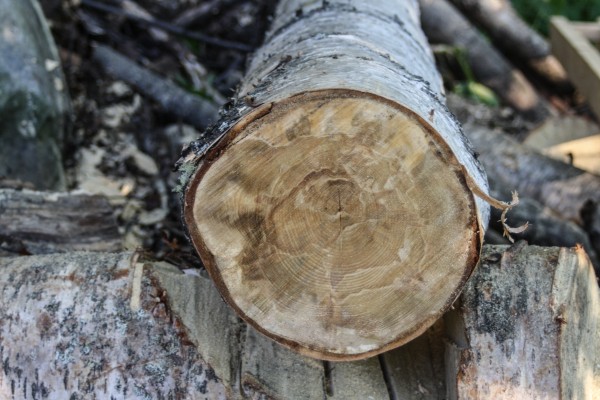
The first step was to buy a chainsaw mill and start milling the trees, most of which had been felled the year before. Milling was one of the most time-consuming but satisfying parts of the process. To take a tree, to turn it into lumber, and to reveal the surprising character of the grain is an exercise in patience and discovery. I took the logs (none of which are very big here in Alaska) and cut them into 8 ft sections. The first step in milling the log is to set up guides and make the initial cut. I did this with a couple straight 2x4s, joint hangers, and a level. I marked my first cut, put the guides in place, and cranked up the chainsaw.
After the first cut, the next step is the vertical cut. Here I used a “mini-mill” attachment for the chainsaw. The mini-mill runs along a 2×6 that has been outfitting with an aluminum guide. After the two sides were completed, I switched back to my regular mill to make the remaining cuts and to slab the wood. I cut most of my wood for the tabletop into 2×6 dimensional lumber. The lumber definitely came out rough-cut and not entirely square, but I used a planer and jointer to fix my mistakes.
After I had what I thought would be enough lumber for the table top, I cut two slabs of birch with the bark and edge still on. These would become the edges of my table. I learned that if one wants to keep the birch bark on the wood, one should cut the trees in the winter then there is little moisture in the outer layers of the tree. Otherwise, as the wood dries, the bark and wood separate. I learned this the hard way, and had to live with table edges that did not include the bark.
After all the wood was cut, I had to dry it. I brought it to my dad’s barn, where I stacked the wood, then weighted it down. The wood sat there for a year, and when I came back this summer, the wood was quite dry. I began the process of squaring the wood with a jointer, a table saw, and a planer. One of the miscalculations I made was how much material I would have to take off of the wood get them square. I intended to make the table top 1.5″ thick, with planks 5.5″ wide. I quickly realized I needed to take off far more material to get the pieces square. Even though I cut the wood with a 1/2″ of extra thickness, I ended up with planks that were only an inch wide, and about 5 inches wide.
After the planks had been planed, I went about the process of joining them. I used the combination of a Kreg jig, wood glue, and pipe clamps to join the planks. In hindsight, I should have paid more attention to the direction of the grain (as I hear it helps keep the tabletop flat). By the time I had connected most of the planks, there was a noticeable bow starting to show in the table top.
I ended up taking the two edge pieces off, snapping a line, and carefully using a circular saw to re-straighten the edges of both boards. This seemed to help. My next step was to create the frame and legs. I didn’t have the lumber to do this from my seasoned lumber, but I had some logs still on my property from the summer before. Once again I found myself on the mountainside, milling lumber. I made a basic frame with 2×4 lumber I milled, and created simple 4″x4″ legs for each corner. I put a few layers of polyurethane on the frame and called it good.
The next step, and perhaps the most stressful, was pouring the epoxy on the table. I sanded the tabletop, added several layers of polyurethane, and grabbed a gallon of epoxy from the local hardware store. I set the tabletop in a small room without dust, spread plastic everywhere, and started the pour. 1 gallon was just barely enough to cover the surface, and it my stress to make sure the table was properly covered, the pour ended up being uneven. It left small dimples on one side of the table. I used a torch to pop the bubbles in the epoxy and called it good, though I was still dissatisfied with the dimples. I left the tabletop to cure for several days, then connected it to the frame.
I used simple 4″ x 4″ legs which I attached to the bottom of the frame when I brought the table home. The finished product looks something like this:
After we got the table home, I was still unhappy with the dimples in the epoxy from my first pour. In addition, the epoxy was still curing and the kids managed to scrape it up pretty bad. I decided to do a second epoxy pour, which ended up far better than the first one. We’re still using mismatched chairs with the table but that’s next summer’s project: small bench seats made from half-rounds of birch. It should be a fun challenge.
How to Make Birch Syrup
With winter quickly melting away, the trees are just beginning to swell in preparation for spring. That can only mean one thing: time to make birch syrup.
We made birch syrup for the first time last year and tapped 10 birch trees in our yard. It was a grand experiment, and far more labor-intensive than I had imagined. Below is the process we used, as well as some notes and links to other birch syrup resources.
Birch sap is far thinner than maple sap. In fact, it takes about 100 gallons of sap to make a gallon of syrup. Birch sap begins to run in early April, so now is the time to consider harvesting.
Tools you’ll need:
- A drill and 7/16″ drill bit
- Plastic spiles (can find some here)
- Plastic 5 gallon buckets
- A shallow pan to evaporate sap (we used a roasting pan)
1. Drill holes
Sap runs up the tree around the perimeter — in fact, nearly all of the water is drawn up the tree just under the bark. If you’ve ever nicked a birch tree this time of year, you’ve seen how profusely they weep sap.
Drill holes 1 1/2 inches deep, on the north side of the tree, at a slight upward angle. Place a piece of tape on your drill bit (as shown below) to ensure proper depth.
Holes should be drilled on the north side of the trees. This prevents the buckets from heating up in the sun unnecessarily, which reduces the chances of the sap spoiling. Holes should be offset from previous years’ holes.
Find trees that have a large diameter, and are somewhere that you can easily access. Each tree can produce over a gallon a day, and with only 10 trees, we were still hauling heavy buckets of sap up and down our steep lot!
Spiles should be gently tapped into the tree. You want the spile to be firm in place so no sap can escape around the edges, but not so tight that it impedes sap flow or cracks the sap wood.
3. Place a bucket under the spile.
Some people place mesh or other material on top of the bucket to reduce the amount of bark/bugs/etc that collect in the sap. I just ran all my sap through a tea filter or cheesecloth to remove any foreign material.

Birch sap dripping from the spile. At the peak of the sap flow, some trees produce more than a gallon of sap a day.
4. Collect sap once a day. Filter it and simmer it.
Sap must be collected daily. Because it’s water full of nutrients, it is easily contaminated by microorganisms if left out in the sun too long.
Evaporating the sap was by far the most time-consuming part of this process. We first tried evaporating it on a camp stove, but was going through fuel canisters way too fast. Eventually, we settled on using roasting pans on the stove. Our gas bill was substantially higher the month we made syrup, the windows had to be open to release all the moisture in the house, and the stove was running 8-12 hours a day. Commercial producers use reverse osmosis to remove most of the water, then evaporate the rest.
We ended up boiling the sap until it reduced by half, then simmered it on low until we removed the rest of the moisture. We had no way to determine how much water was left in the syrup, so we simply let it simmer on low until it appeared “syrupy.” Remember, five gallons of sap only creates about a 1/2 cup of syrup.
5. Put the syrup in jars and enjoy!
Syrup is fairly shelf-stable, so we simply boiled some canning jars, warmed the syrup, and placed the syrup in the jars. We didn’t process the jars at all. We found the syrup to have a stronger taste than maple. It was very reminiscent of molasses. We used it on pancakes (and I want to incorporate some into my homemade bacon brine). However, I have a friend who look a few pints and made a fantastic birch stout.
Additional articles:
Great guide from UAF cooperative extension service
Info from Kahiltna Birch Works
Info from birch Boy (SE Alaska)
Online source for spiles:
https://www.leaderevaporator.com/p-209-plastic-516-hooked-spout.aspx
No One Howls Anymore
I’ve been recently teaching my students Whitman, and introduced them to Ginsberg. While I haven’t written any poetry in a while, I really got inspired by rereading “Howl” and “America” by Ginsberg. At the same time, I have come to the conclusion that I fundamentally hate the 21st century (perhaps more on that later). Anyhow, here’s a quick poem written as a nod towards Ginsberg’s poetry and style.
I saw the best minds of my generation
destroyed by a billion tiny screens in silence.
Dreams, thoughts –personal fucking agency —
abandoned to the quiet cadence of mouse clicks,
rhythmic typing, fingers touching glass, searching for connection
on that cold and flawless surface.
I saw the young bodies of my comrades fold into themselves —
unnatural arches of the spine, heads down-turned in reverence to their
tiny gods.
I saw our hours consumed with raving mad images — bodies and breasts and mountains and makeup —
an unceasing scrolling tumbling river of images,
hope and sighs thrown out tinted windows at highway speeds
I don’t think they’ll be returning anytime soon.
No one howls anymore.
Our pockets contain: lint, screens, the entirety of human knowledge
and always loneliness, crouching.
Where are our words?
Why don’t we use “whom” anymore?
Why did I find the best of our language outside my neighbor’s trash can, sticky and damp from the rain?
I want to speak with you, brothers.
I want to touch you, sisters.
Let’s tell the world we knew to fuck itself
and then take a walk in the woods.
Let’s call ourselves pirates and go build a tree house.
The only thing the world can’t give us is innocence.
Maybe it’s lying in the neighbor’s trash too.
I better go find it under the rocks in the creek,
maybe in the way you take off your clothes.
Oh, and my friends don’t fuck anymore.
They recline pillowed heads,
intoxicate themselves with their blue pixies instead.
500 million bedrooms are strangely quiet — it’s becoming unsettling to me.
I give up on you, America,
you and your blue pixies.
I’m tired of your madness cloaked in silence,
your impotent, naked demands.
You’ve stolen my mind.
I’m starting to lose it
and all I can hear is your evil touchscreen symphonies.
I’ll find it though.
You won’t keep it from me forever.
And I’m starting to get the inkling
it’s around here someplace.
Reflections from the trapline
The woods after the first snowfall have a distinctive sound. The world becomes quieter, and any remaining sound is muffled, as though filtered through cotton. It’s in this new silence that I find myself snowshoeing through the trees. My headlight illuminates the forest ten feet in front of me — the entirety of my universe at this moment. Nightfall is arriving earlier every day here in Alaska, and these woods, now dark and covered with snow, seem strangely unfamiliar.
As I walk, I come upon tracks. With the recent winter storm, these tracks cannot be more than a day or two old. Here a squirrel raced from one spruce tree to the next. As a trapper, one begins to see the world through the eyes of the animals. I cannot help but think of the squirrel as he hopped through the snow. Was he full of fear as he moved through the open, looking skyward for an eagle or owl? Has he stored enough food for the winter? As I imagine him rushing over the snow, anxious and alone, I can almost sense that same feeling of trepidation running through my nerves.
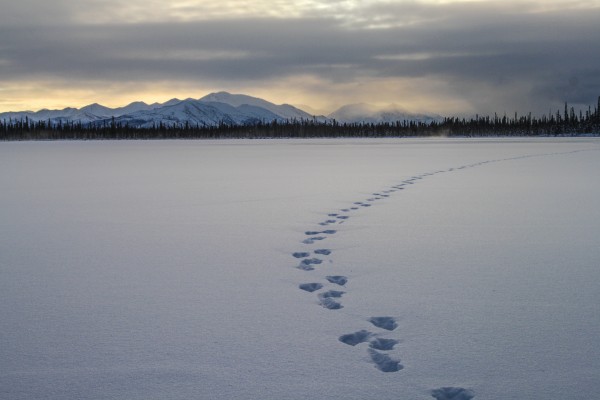 Here an arctic hare made his way along the edge of the willows. It’s been years since I’ve seen many hare tracks on this mountainside, and their huge, soft prints bring a smile to my face. They’ve returned.
Here an arctic hare made his way along the edge of the willows. It’s been years since I’ve seen many hare tracks on this mountainside, and their huge, soft prints bring a smile to my face. They’ve returned.
Hare populations increase and decline in an almost clock-like fashion. Some years their trails crisscross the snow like highways designed by a madman. The animals are pure white and difficult to see, so their roads and back alleys are usually the only sign that they share the woods with me. When they are abundant one can sense their presence from their shadows moving across the snow. Eventually though, their population will collapse. A combination of overpopulation and predation takes their toll, and one winter their tracks will be gone. It will be a few years before I will see their tracks again, and ten before they once again lay down their snowy highways.
The trapper lives within this same cycle of plenty and hardship. The populations of fox, lynx, and coyote mirror the populations of hare, shrew, and squirrel. Trappers must accept, just like the animals they pursue, that their will be lean years and abundant years. Some winters the landscape seems eerily empty — as though it has been entirely abandoned. Other years, signs of winter life is etched into the snow with myriad footprints.
Trappers can help temper these cycles of overpopulation and collapse. Even to this day, trapping regulations usually stipulate no limit on the number of animals one can harvest in a season. It is up to the trapper to understand these cycles and not exploit the land. If an area is over-trapped, the breeding population of furbearers can no longer maintain itself and the animals will disappear. The landscape is out of balance, and will remain out of balance for some time.
Likewise, areas that remain untrapped suffer the worst of the boom and bust cycle. Without trappers to temper the number of predators, they can decimate the population of prey animals making the recovery of prey populations harder. Trapping, in some way, is stewardship of the land. It’s entering and participating in the natural cycles of the wilderness, while still being conscientious of it; making sure one never takes too much…
As I continue to walk, I come across fox tracks. A line of deep, straight dimples stretch across the snow in either direction from me. As I follow the tracks, I once again see the world from eyes other than my own. Where was he headed? Was he simply strolling through his territory, enjoying the silence as I do now? Perhaps he was hungry, cocking his head to one side to catch the impossibly faint sound of a shrew beneath the snow. I do not know, but I play all these scenarios through my mind, trying to enter his.
In a world where we think of all knowledge as coldly scientific, a trapper, hunter, or fisherman holds knowledge that is deeply personal. The favorite tree of the resident grouse. The small creek that never seems to freeze. The unpicked harvest of cranberries still on the bush. A trapper find a small piece of earth and lets it teach him. In this way, those lonely souls walking the woods at night carry a knowledge that is deeply personal and utterly unique. They “know” a landscape in a way no one else does.
Many people think of trapping as an activity that is somehow exploitative and wasteful. The idea of harvesting an animal for its fur, in the era of Gore-tex and nylon, seems unnecessary. They visualize scared-looking animals in traps, their dignity stripped from them. The reality of trapping is far more complex.
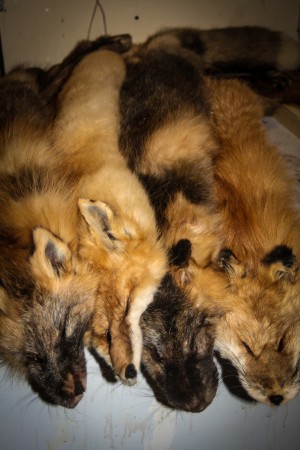 When I come upon my catch, there is a mix of emotions. Certainly there is a feeling of pride. I’ve learned what the landscape has been able to teach me. All the scouting, preparation, and work have not been in vain. I’ve entered the animal’s world and have played a fair game.
When I come upon my catch, there is a mix of emotions. Certainly there is a feeling of pride. I’ve learned what the landscape has been able to teach me. All the scouting, preparation, and work have not been in vain. I’ve entered the animal’s world and have played a fair game.
Often that pride is accompanied by sadness. I’ve spent weeks, maybe months, playing the game and now the game is over. His tracks will disappear from the landscape, hopefully to be replaced next year.
Above all, there is a feeling of respect for the animal. Touching its coat, feeling the softness and warmth, one cannot help but respect an animal that can thrive is such conditions. Every time I catch an animal, I carry it home in my arms. Part of this is pragmatic — I don’t want to damage the fur — but part of it is symbolic. The animal, whose life has been long extinguished, still deserves respect. Many emotions run through me in quick succession as I cradle it in my arms.
Trapping essentially centers around mortality, and I don’t think that fact is lost on many trappers. Trappers delight in a “clean catch,” where the animal was quickly killed and didn’t suffer much. Likewise, one is filled with remorse when one occasionally catches an animal improperly and it’s death was unnecessarily long.
I think about mortality a lot while I’m on the trapline. As I watch relatives die from cancer, as I notice parents getting older and slower, and as I carefully lift the stiff and cold weight of a fox out of the snow, I cannot help but think about death. How will I go? The trapline has illuminated my thoughts on my own ending. My hopes for the fox and myself are the same. In the end, I’m just hoping for a “clean catch.”
Skinning the animal is equally respectful. A well-skinned fur will fetch far higher prices than a sloppy one, but the ritual is more than that. It takes me about an hour and half to skin a fox. Every movement is a gentle one as I use my knife and my fingers to slowly undress it. Its scent fills my nostrils. I fuss and worry over it. For time to time, and step back purely to admire it.
Once the skin is off, stretched and dry, I take a hair brush and softly comb the hair backwards, revealing the thickness of the fur. It is a final ritual before I put the fur up, to be tanned or sold.
Most humans don’t receive such burial rites.
Once the fox is skinned, I take the carcass and strap it to my backpack or sled. I bring him back to woods, using him as bait for another set. Chances are, the ravens and eagles will get to him first. Most of him is returned to the land from which he came…
Tonight, however, my snares are empty. The fox has been hunting another part of his territory, and his tracks merely pass through this piece of woods. I leave the forest and pull my frosty hat off my head. Behind me, the quiet forest — my tracks mingling with his.
Thoughts on the gardening season (2013)
We just pulled the last of the potatoes and carrots out of the garden today, and I figure its time to reflect on this year’s growing season. 2013 was one of the nicest summers in recent memory. We received a ton of sunshine, and multiple days (and even weeks) in the 80’s. That’s unheard of for this part of Alaska. In addition, this was the first year we had a greenhouse, so I had the opportunity to grow veggies that I’ve never been able to grow before. Below are a series of notes about our season, and some reflections upon it.
The Greenhouse
All of our plants in the greenshouse did well, though our weeks of heat certainly stressed them, particularly the tomatoes. Even with a big wall fan running and all the vents and doors open, the greenhouse was still hovering around 100 F. I think that had a detrimental effect on the tomato growth, as the leaves curled and growth was slowed for nearly a month.
Speaking of tomatoes, we grew three different varieties: a wild cherry, a large slicing type, and Amish Paste. The slicing variety was by far the most productive. Overall, I had hoped for a larger harvest, but the aforementioned stress likely diminished our harvest. Next year I plan to try both determinite and indeterminite varieties and test which type is best for our short growing season.
Our first year of cucumbers was a huge success. We planted pickling cucumbers and an English-style greenhouse variety. They both did phenomenally, and both seemed to deal with the heat well. Our only complaint was that the picking cucumbers became bitter from heat stress during the hottest part of summer.
We planted three different varieties of peppers: jalepenos, a ristra type, and bell peppers. All the peppers did well, though the bell peppers weren’t nearly as prolific as I would have liked. I’m not sure if we planted them in too small pots, or if the variety we had was not ideal, but I’m thinking we won’t be planting many of them again.
Total Failures:
We tried pumpkins, sweet corn, cantaloupe, and watermelon in the greenhouse in containers this year. It was a total failure. Only the pumpkins put out decent blossoms, but even after having hand-pollinating them, the fruits rotted and fell off before maturing. We’ll use that space in the greenhouse for more tomatoes.
Speaking of failures, our onions were a complete failure this year. I bought onion starts and also grew a bunch from seed. I think the heat, combined with a very late spring, did them in.
While our fruit trees blossomed, none of them produced fruit this year. I’m not sure what that was about, but I suspect our strange spring (snow very late into the spring, then sudden, unseasonable warm temperatures) messed with the trees.
Berries:
Currants, raspberries, and rhubarb all did very well. We picked over 10 lbs of raspberries from our humble raspberry patch, and I was finally able to harvest our domesticated currants before the chickens got them. Wild berries were unbelievable this year as well. I’ve never seen larger blueberries in my life.
Honey:
With the warm summer came an excellent honey harvest. The bees had many, many days to fly and collect nectar. However, two factors worked against me this year. First, the spring was ridiculously cold. I literally had to dig through 2 ft of snow to find ground in order to set up my bee hives. I think the cold weather meant the colonies did not build up their populations as quickly as normal. Second, I had serious queen problems. In one hive, I tried to set up a 2-queen system, but for the second year in a row, it didn’t work out. In the other hive, I had a rogue queen hiding in there somewhere. She killed three other queens before I could confirm she was in there and producing eggs. What a pain. Nonetheless, we ended up with 45 lbs of honey from the two hives. Next year I’m shooting for 60-70 lbs.
Other Notes:
Cabbage, broccoli, potatoes, carrots, turnips, zucchini, salad mix, peas and lettuce all did well. They seem to be the consistently good veggies up here.
We did a bunch of canning this year! With the greenhouse produce, we had the opportunity to try canning a number of different things. We canned tomatoes, salsa, pickles, garlic scapes, and jalepenos. While the canning can be a lot of work, it’s satisfying to finally be able to preserve more of our harvest for the winter months.
The freezers are full of salmon, halibut, moose, and caribou, and the last of the yard chores are done. It’s finally time to wait for our first real snowfall, and look forward to the beginning of trapping season. Once trapping season is over in February, it will be time to start thinking about the growing season once again…
How to Make Salmon Roe Caviar
I’ve always wondered about making salmon caviar. I love tobiko and other fish eggs on my sushi, and every time I’ve thrown a skein of roe into the river as I cleaned my salmon, I wondered it I was, in fact, throwing away an edible part of the fish.
This year, I met a woman originally from Russia on the banks of the Copper River. She talked to us about making salmon roe caviar and my interest was piqued. Upon further research at home, I discovered that the UAF Cooperative Extension Service actually published a guide to making salmon caviar. I followed their recipe both times I made it, but there are much fancier recipes out there I’d like to try.
Below is the process of making the caviar.
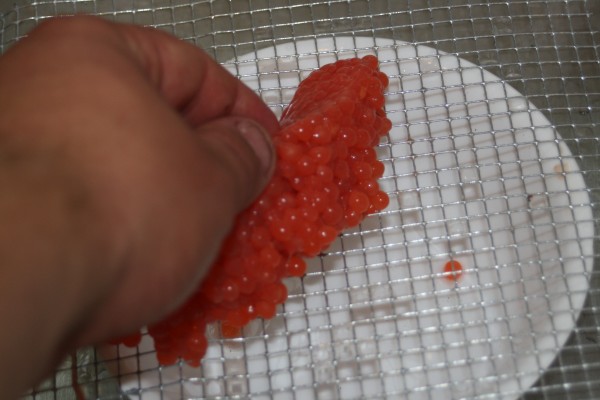
Rub the skein of eggs over the wire mesh. This will separate the individual eggs from the skein tissue.
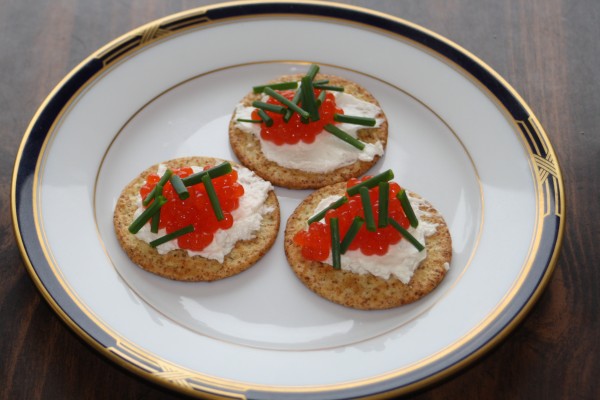
Refrigerate. The eggs will keep for about two weeks. They taste fantastic with cream cheese, crackers, and chives. They’re also great on scrambled eggs!
In terms of taste, the eggs are almost entirely tasteless. I would argue they simply taste “salty, fresh, and rich.” More than anything, they add texture, color and richness to whatever you are serving, and they seem to be very versatile.
My 100th Post! (And a video)
This summer has been a busy one, and while I have many things to write about here, I simply have not been able to slow down long enough to actually write. (Look soon for posts on making birch syrup, making salmon caviar, milling lumber with a chainsaw and more!) In the meantime, I decided to make my first little “how-to” video. I went out with the boys and picked 10 lbs of red currants the other day to make my annual batch of currant-raspberry mead. I was dreading cleaning all those berries, then a simply idea dawned on me. (See video below.)
The Greenhouse
I’ve been wanting a greenhouse for a couple of years now, and this spring we finally made it happen. Warm weather crops like tomatoes, peppers, cucumbers, and the like are nearly impossible to grow here in Alaska without a greenhouse. While I’ve been able to successfully grow tomatoes, sweet corn, acorn squash and pumpkins here in Alaska without a greenhouse, it has required raised beds, hoop houses, and some serious luck.
With a greenhouse, we should be able to grow much healthier, productive plants. New veggies mean new challenges, which always makes for an interesting growing season.
The greenhouse is 16×10 feet, with seven foot walls. The peak of the roof is probably 10′ high. I built the floor for the greenhouse last fall just before the snow began to fall. The floor is built on 4×6 skids, supported with “linkin-log” style 2x6s underneath to keep it level. We have a pretty good slope to our yard, so while one side is ground level, the other side of the greenhouse is 4′ off the ground.
I threw a tarp over the floor this winter, then shoveled off the snow in March in order to build the walls and roof. My father-in-law had old fiberglass greenhouse panels that had been sitting in his yard for nearly 30 years. Although they were completely buried in leaf litter, they still had some life in them, and saved me over $1000 dollars in supplies. An acquaintance was getting rid of a very nice glass french door a couple years ago, which provided a beautiful (and free) entrance.
I ran out of old fiberglass panels before I got to the last side of the greenhouse, but because that side is north-east facing, with the mountainside behind it, I just covered that side with plywood that I’ll paint this summer. We shouldn’t lose much light, as the sun never shines from that side.
I haven’t built benches yet, but that project may wait until next year. For now, 5-gallon buckets on the floor should work just fine.
The plan this year is to grow 30-35 plants in the greenhouse. We’ll have a good variety of tomatoes, peppers, and cucumbers. The boys want me to grow sweet corn and pumpkins, so we may try those in containers as well. The greenhouse has already been up to 74F this week, with ambient temperatures only in the 40s, so it won’t be long!
All the best as you get ready for growing season!
An Unwelcome Guest
Today I came home from a hike and decided to give the chickens fresh water. As I was walking down to the chicken coop, I noticed three of the chickens outside in the sun. I was a little surprised, considering there is still a lot of snow on the ground, but I had shoveled a path for my little ladies a few weeks back, and I figured they were simply enjoying a warm and sunny spring day. I smiled as I passed them and said, “Enjoying the sun today, huh ladies?”
I opened up the chicken coop door wide.
What happened next, though it only took a total of two seconds, is as clear as day. I opened the chicken coop to see white feathers on the ground. That seemed unusual and just as I comprehended that something must have entered the coop and killed a chicken, I saw it: a red tailed hawk standing on the chicken roost three feet away. We saw each at about the same time and the hawk, frightened and clearly unable to find his way back out of the coop, flew into the window 2 feet from my head with a crash and dropped to the ground, then flew back up onto the perch.
Before I even had time to shout my favorite four-letter word, I had the slammed the door. Staring at the closed door, I took a moment to confirm what I had just seen. There was a giant hawk stuck in my chicken coop.
Now the thinking began: how was I going to get this raptor out of the coop? He certainly couldn’t find his own way out but the idea of hitting a hawk with a broomstick until I shooed him out of the coop somehow sounded like a giant cluster-f**k. There was no telling when he’d eventually figure out how to get out, and in the meantime, the rest of the chickens were sitting in the snow, looking very paranoid about life.
Finally it dawned on me: if I opened the coop door wide, as well as the outside door to the coop/shed, there would be a seemingly large path for him to fly out. First, I took some pictures. I opened the door just enough to sneak my camera through, lest he think it a good idea to attack me. After showing the boys the hawk, I sent them and their mother up to the house while I opened both doors at the same time. Just as before, the hawk tried to fly through the window, and crumpled to the ground. This time, however, the hawk saw the opening and flew out as fast as his giant-killer-raptor-wings-of-death could carry him.
Thankfully, he only killed one chicken, and hopefully learned his lesson.
Rest in peace, Blizzard the Chicken. You laid tasty eggs.

